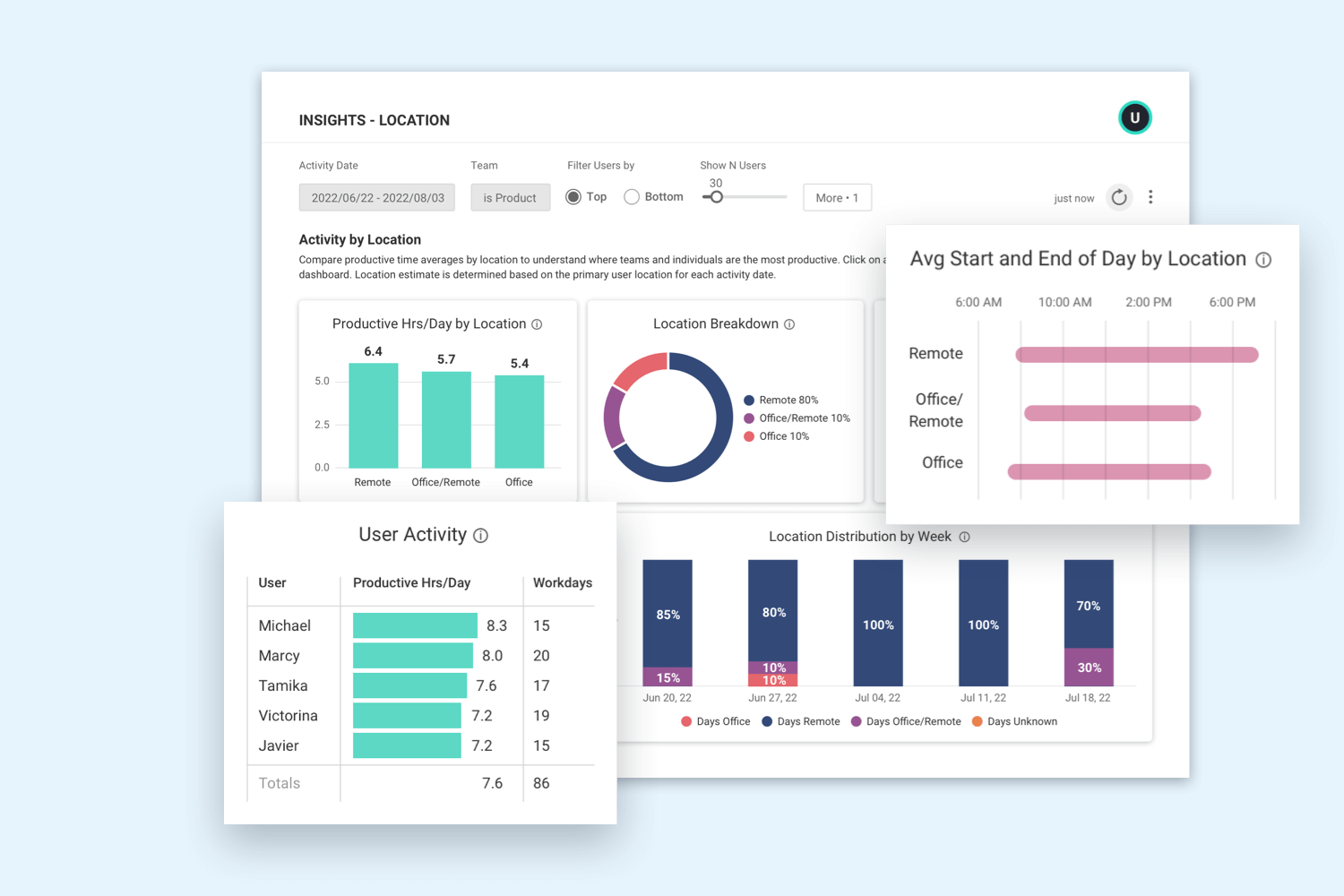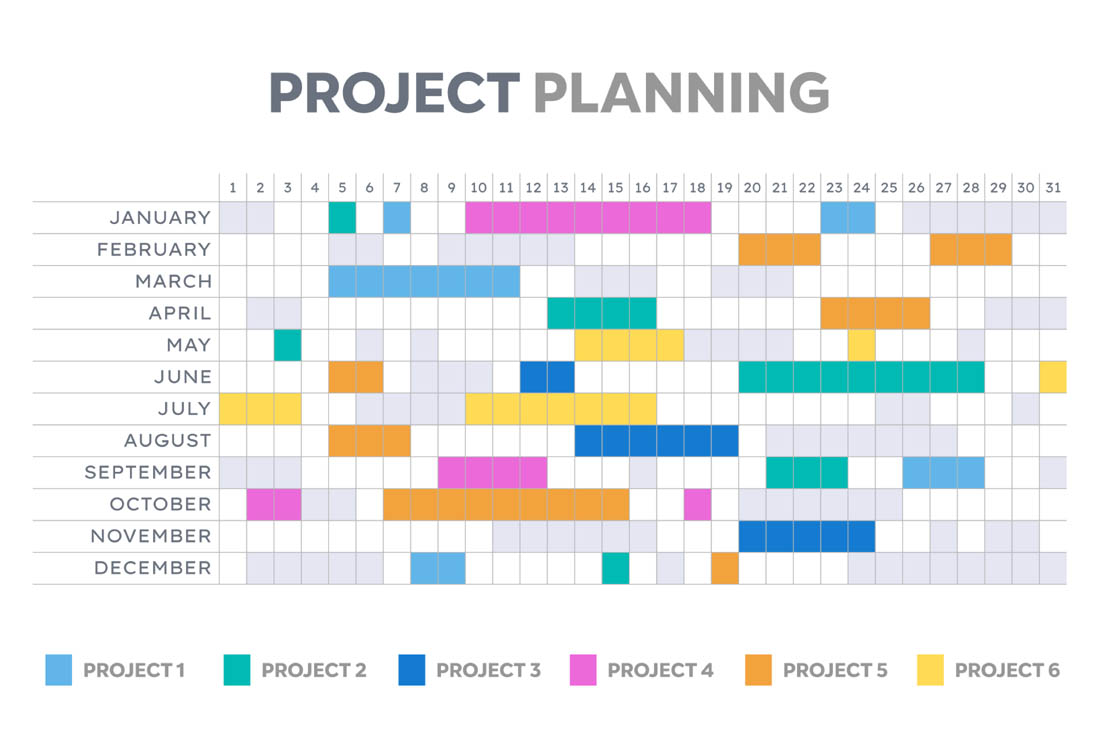Over the past several months, we’ve seen companies across the globe do something remarkable: They’re reimagining long-held conventions about the nature of the workplace to develop new models based on employee feedback and business priorities. As we make this monumental shift toward flexible work, we must recognize and address the pain points that go along with it. Hybrid and remote models can work, but we can make them work even better.
And this is why I’m thrilled to introduce one of ActivTrak’s most pioneering features yet: Location Insights. Our team set out to solve what we (and our 9,500+ customers) identified as one of the most pressing issues organizations face today: how to develop an optimal hybrid work policy based on objective data about where employees work — and where they work best.
5 Questions Location Insights Answer
With Location Insights, leaders and managers can address the following questions to drive performance improvement, elevate employee experience and optimize workforce operations.
1. What is the ideal workplace policy for our organization?
Use Location Insights to understand the impact of workplace policy on employee productivity and operations.
In developing a hybrid work policy, the underlying goal for most organizations is to balance employees’ desire for flexibility with the needs of the business. To determine the right policy for your organization — or evaluate the impact of policies you’ve already implemented — it’s critical to have an ongoing feedback loop in place. With clear, objective indicators of employee productivity and engagement, leaders and managers can experiment with different policies at the organizational and team level, assess the impact and refine as needed.
Leaders and managers can leverage Location Insights to answer the following questions:
- Are employees who are fully in-office as productive as those working from home?
- For hybrid employees, do working hours and productivity differ when working remotely vs. in the office?
- Is there sufficient overlap in team members’ working hours to allow for regular collaboration?
- Is the workplace policy being followed? Do we see behaviors deviate over time?
2. Is our hybrid work policy contributing to burnout, distractions or low output?
Use Location Insights to understand if productivity and engagement challenges are associated with specific environments.
Fatigue, burnout and low engagement pose serious threats to employee retention — especially in a competitive job market. Tenured workers are resigning in search of new employers who promise greater flexibility and work-life balance. To better understand and mitigate these risks, it’s important to evaluate the factors that contribute to disengagement and attrition.
Using Location Analysis, leaders can assess:
- Do remote employees tend to work longer hours due to an “always-on” expectation?
- How much time do in-office employees lose to commutes? How does this affect their productivity or morale?
- Do hybrid employees have clear guidance about which days or how much time they’re expected to spend in the office?
The purpose of these insights is not to build a case to reverse policies, disrupt operations or penalize employees. It’s to help leaders, managers and HR business partners understand how they can better support employees and enable healthy working habits in all work environments. With greater visibility into various needs, businesses are far better positioned to provide the timely, tailored and relevant support their employees need to achieve sustainable productivity.
3. How does our workplace policy affect the success and experience of new hires?
Use Location Insights to help ensure the success of newly onboarded employees who may need additional support and cultural integration into your company.
When developing workplace policies, it’s critical to consider the impact on the onboarding process and experience for new hires. To feel valued and be successful in their role, new employees must have clear expectations about their responsibilities, learn how to navigate company systems and processes, and build relationships with teammates and cross-functional partners — all of which can be more difficult without the benefit of face-to-face interaction.
Team managers and HR professionals should consider the following questions, leveraging Location Insights to provide data points:
- How long does it take new hires to achieve productivity levels similar to their teammates’? Does this differ for in-office vs. remote employees?
- Does attending in-person onboarding lead to a faster ramp-up in productivity?
- Do new hires receive clear communication about when or how often they should be in the office?
4. What is the role of the office, and how much space do we need?
Use Location Insights to inform commercial real estate decisions.
If the office is no longer the primary place of work, what purpose should it serve? How does this factor into your hybrid work policy? If leadership decides it’s important for employees to spend at least part of their time in the office, it’s essential to develop guidelines that connect the “when” and the “how often” to the “why.” Arbitrarily deciding that employees must spend three days a week in the office is likely to be met with pushback and possible attrition in place of delivering real benefits. For instance, if the office is intended to facilitate collaboration and camaraderie but teammates are rarely there on the same days, there’s probably not much collaboration taking place.
Leaders and managers can reference Location Insights to assess whether an organization’s hybrid work policy delivers expected outcomes. Consider the following questions:
- How often do hybrid employees come into the office?
- When employees are in the office, do they spend more time in in-person meetings than in virtual meetings?
- Do the same employees come into the office on a routine basis or is the group ever-changing?
- Are employees coming into the office for meetings or individual focus time?
5. What technology solutions elevate productivity?
Use technology adoption data to understand how apps and websites address in-office and remote needs.
Technology solutions for in-office and virtual workspaces are abundant. While some elevate meeting quality and participation, others showcase employees’ needs for focus time or brainstorming. From better note-taking to improved process workflow management, tech stacks have become more sophisticated in recent years.
That said, the rapid influx of solutions can be overwhelming. New technologies often introduce process inefficiencies that lead to employee frustration and low adoption — all at a high cost to the company (and sometimes more than the cost of the technology itself). Location Insights, alongside the Technology Usage Dashboard, help leaders answer these questions:
- How are in-office/hybrid/remote employees leveraging technology to support productivity?
- Are in-office employees more likely to use a suite of solutions than their remote peers? Is knowledge-sharing in-office unavailable/inaccessible to remote employees?
- Is in-office training more, less or equally effective to virtual training?
- Are remote employees leveraging virtual tools for collaboration and problem-solving as expected?
- Do in-office employees use virtual collaboration and problem-solving tools or are they unnecessary?
Location Insights introduce groundbreaking data analysis in the workforce analytics space
Historically, workforce analytics have been location agnostic. We’ve learned more about our employees as time goes on — broadening our focus on their skill-specific capabilities to consider key details such as past work history, career aspirations, tenure, performance feedback…the list goes on.
What we have yet to consider in this data is the environment where employees actually thrive. We’ve been missing the link between where employees work and how they work — a critical connection to understand if we want to deliver strong business results and the flexibility employees expect.
With Location Insights, leaders, operations, HR and IT professionals — and employees themselves — can understand how their surroundings directly impact their work habits and outcomes. These insights serve as a launching point for companies to better support, guide and elevate employee performance and thus, business success.
Ready to see Location Insights in action? Sign up for a personalized demo or watch our on-demand webinar.





